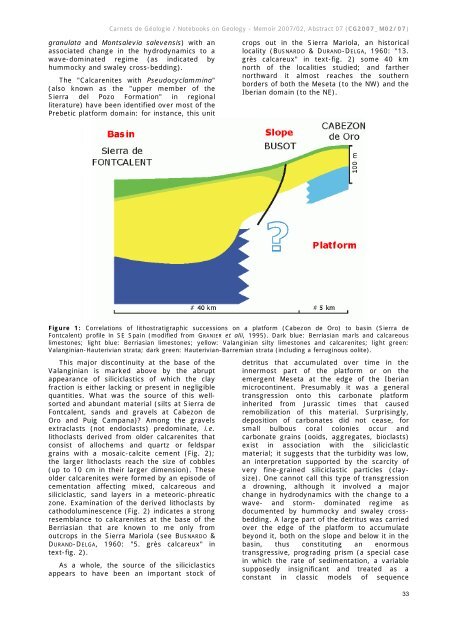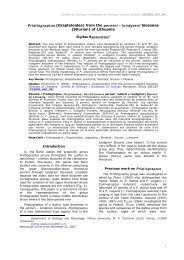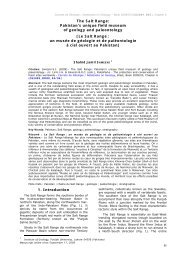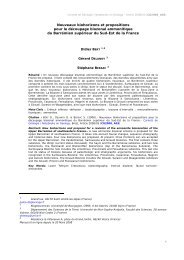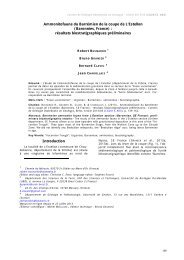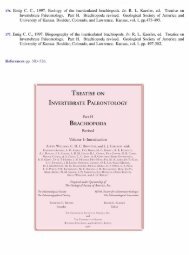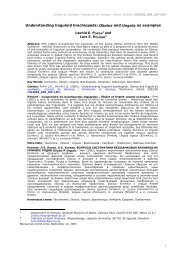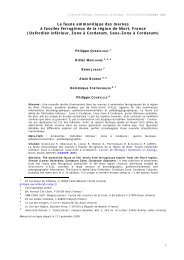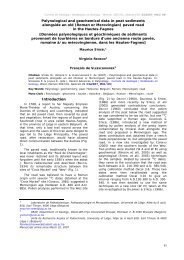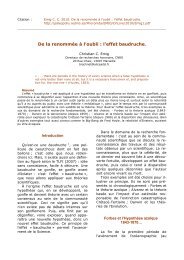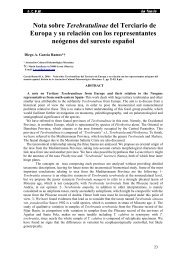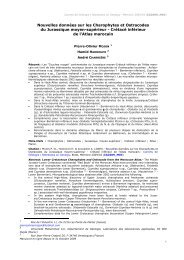Relations entre les marges septentrionale et ... - Paleopolis
Relations entre les marges septentrionale et ... - Paleopolis
Relations entre les marges septentrionale et ... - Paleopolis
Create successful ePaper yourself
Turn your PDF publications into a flip-book with our unique Google optimized e-Paper software.
Carn<strong>et</strong>s de Géologie / Notebooks on Geology - Memoir 2007/02, Abstract 07 (CG2007_M02/07)<br />
granulata and Montsalevia salevensis) with an<br />
associated change in the hydrodynamics to a<br />
wave-dominated regime (as indicated by<br />
hummocky and swaley cross-bedding).<br />
The "Calcarenites with Pseudocyclammina"<br />
(also known as the "upper member of the<br />
Sierra del Pozo Formation" in regional<br />
literature) have been identified over most of the<br />
Preb<strong>et</strong>ic platform domain: for instance, this unit<br />
crops out in the Sierra Mariola, an historical<br />
locality (BUSNARDO & DURAND-DELGA, 1960: "13.<br />
grès calcareux" in text-fig. 2) some 40 km<br />
north of the localities studied; and farther<br />
northward it almost reaches the southern<br />
borders of both the Mes<strong>et</strong>a (to the NW) and the<br />
Iberian domain (to the NE).<br />
Figure 1: Correlations of lithostratigraphic successions on a platform (Cabezon de Oro) to basin (Sierra de<br />
Fontcalent) profile in SE Spain (modified from GRANIER <strong>et</strong> alii, 1995). Dark blue: Berriasian marls and calcareous<br />
limestones; light blue: Berriasian limestones; yellow: Valanginian silty limestones and calcarenites; light green:<br />
Valanginian-Hauterivian strata; dark green: Hauterivian-Barremian strata (including a ferruginous oolite).<br />
This major discontinuity at the base of the<br />
Valanginian is marked above by the abrupt<br />
appearance of siliciclastics of which the clay<br />
fraction is either lacking or present in negligible<br />
quantities. What was the source of this wellsorted<br />
and abundant material (silts at Sierra de<br />
Fontcalent, sands and gravels at Cabezon de<br />
Oro and Puig Campana)? Among the gravels<br />
extraclasts (not endoclasts) predominate, i.e.<br />
lithoclasts derived from older calcarenites that<br />
consist of allochems and quartz or feldspar<br />
grains with a mosaic-calcite cement (Fig. 2);<br />
the larger lithoclasts reach the size of cobb<strong>les</strong><br />
(up to 10 cm in their larger dimension). These<br />
older calcarenites were formed by an episode of<br />
cementation affecting mixed, calcareous and<br />
siliciclastic, sand layers in a m<strong>et</strong>eoric-phreatic<br />
zone. Examination of the derived lithoclasts by<br />
cathodoluminescence (Fig. 2) indicates a strong<br />
resemblance to calcarenites at the base of the<br />
Berriasian that are known to me only from<br />
outcrops in the Sierra Mariola (see BUSNARDO &<br />
DURAND-DELGA, 1960: "5. grès calcareux" in<br />
text-fig. 2).<br />
As a whole, the source of the siliciclastics<br />
appears to have been an important stock of<br />
d<strong>et</strong>ritus that accumulated over time in the<br />
innermost part of the platform or on the<br />
emergent Mes<strong>et</strong>a at the edge of the Iberian<br />
microcontinent. Presumably it was a general<br />
transgression onto this carbonate platform<br />
inherited from Jurassic times that caused<br />
remobilization of this material. Surprisingly,<br />
deposition of carbonates did not cease, for<br />
small bulbous coral colonies occur and<br />
carbonate grains (ooids, aggregates, bioclasts)<br />
exist in association with the siliciclastic<br />
material; it suggests that the turbidity was low,<br />
an interpr<strong>et</strong>ation supported by the scarcity of<br />
very fine-grained siliciclastic partic<strong>les</strong> (claysize).<br />
One cannot call this type of transgression<br />
a drowning, although it involved a major<br />
change in hydrodynamics with the change to a<br />
wave- and storm- dominated regime as<br />
documented by hummocky and swaley crossbedding.<br />
A large part of the d<strong>et</strong>ritus was carried<br />
over the edge of the platform to accumulate<br />
beyond it, both on the slope and below it in the<br />
basin, thus constituting an enormous<br />
transgressive, prograding prism (a special case<br />
in which the rate of sedimentation, a variable<br />
supposedly insignificant and treated as a<br />
constant in classic models of sequence<br />
33


